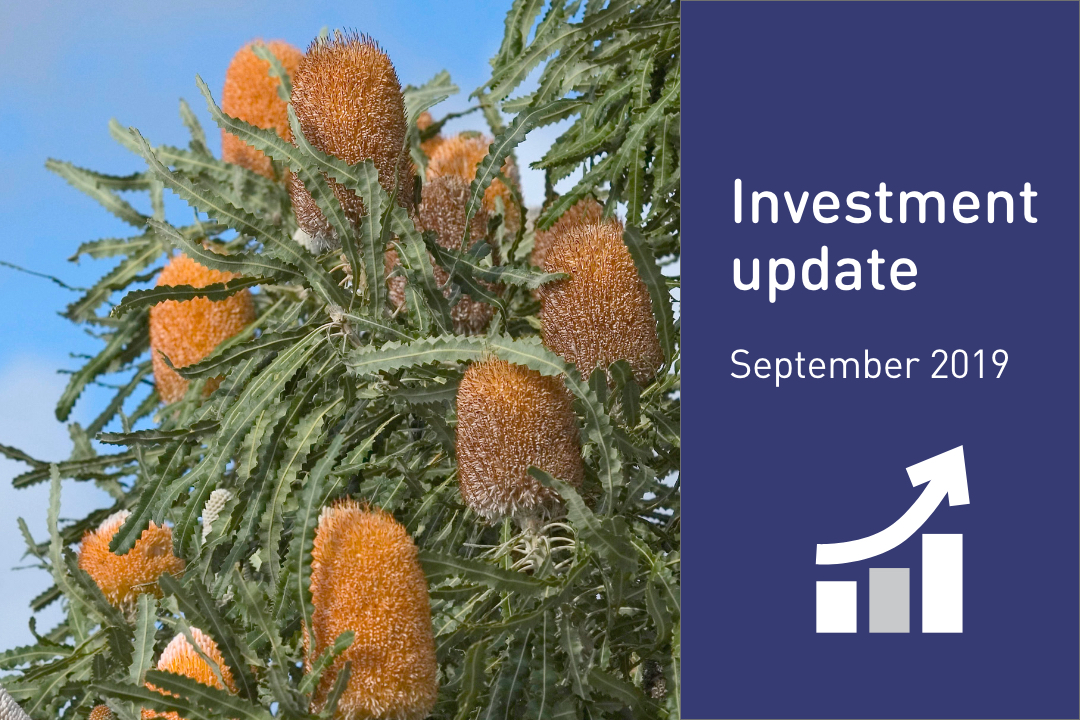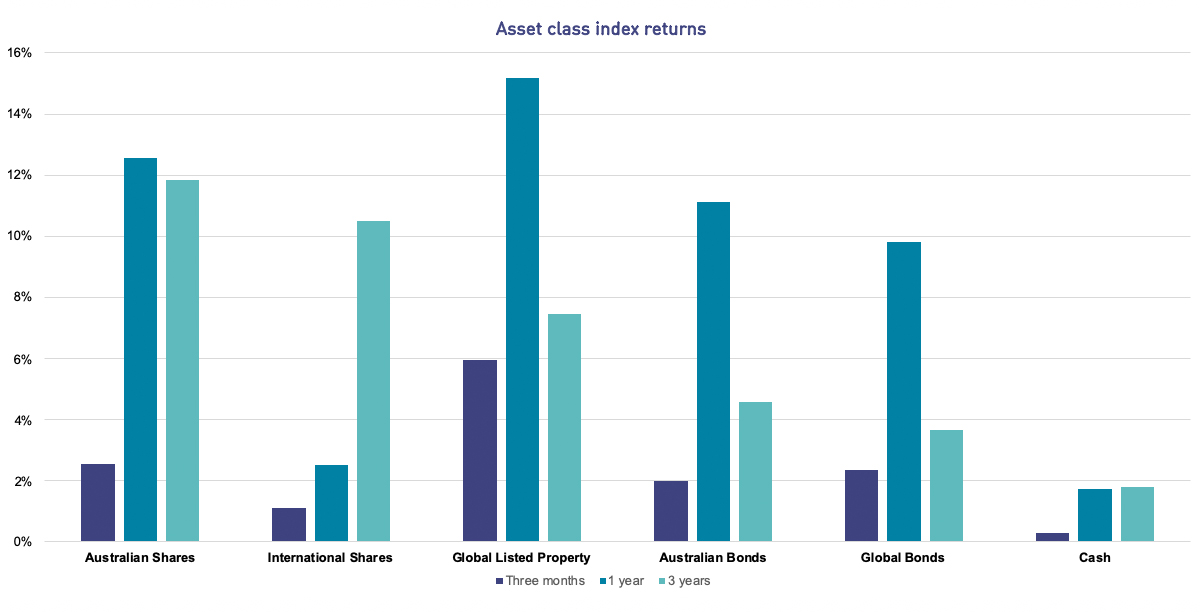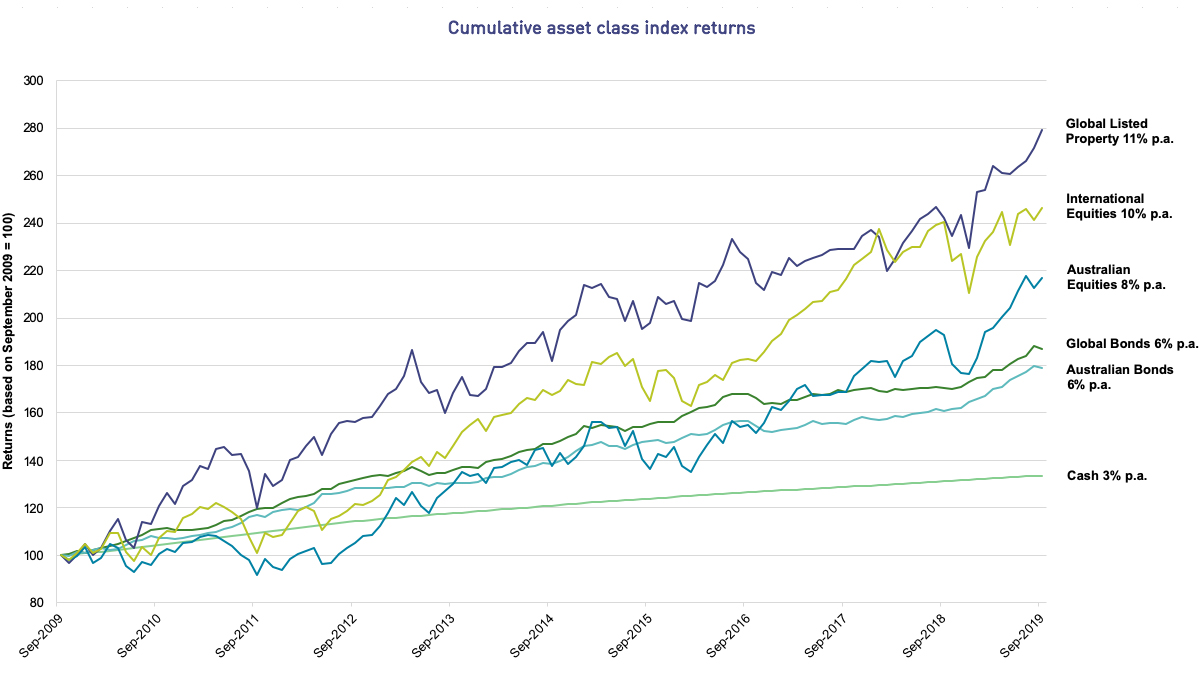Investment update – September 2019 quarter
Key highlights
- Bond and share market returns were supported by interest rate cuts in Australia, the US and Europe
- However, global economic data continued to weaken with the risks of recession rising
- Meanwhile, US-China trade tensions continued to simmer
- Global Listed Property added almost 6% over the quarter to be the top performing asset class. It was also the best performer over the last 12 months
- Australian Shares and Global Bonds returned around 2.5% over the quarter to be the next best performing asset classes
- My GESB Super returned 2.10% for the quarter
- My West State Super returned 2.04% for the quarter
- RI Allocated Pension Conservative plan returned 1.54% for the quarter
Investment market returns: short and medium term
Major asset classes delivered positive returns over the three months to 30 September 2019. The returns over the past year and past three years were generally strong, as shown below.

What were the main reasons for recent investment market returns?
- The US-China trade standoff continues
The US announced a marked increase in tariffs and China retaliated with its own measures including a devaluation of its currency (Chinese renminbi). There was some relief in September as the US and China announced talks would resume in early October, giving rise to optimism. - Risk of recession has increased
US short-term interest rates moved higher than long-term rates during the quarter (long-term interest rates are normally higher). As a number of US recessions have been preceded by this phenomenon, investors became more concerned about a possible global slowdown. - Share markets were mixed during the quarter
Despite the rising risks in the global economy, share markets across developed countries made small gains. European shares rallied the most on the European Central Bank’s interest rate cut and announcement of a new stimulus package. Across emerging markets, those most sensitive to a rising US dollar came under pressure including South Africa and Indonesia.
The Australian share market finished the quarter higher led by financial stocks. Overall, the market responded positively to the interest rate cut in July (following the cut in June) by the Reserve Bank of Australia. - The United States Federal Reserve (Fed) cut its interest rate twice during the quarter
The official US interest rate is now between 1.75% and 2% following two 0.25% cuts in July and September. The uncertainty over trade appears to be impacting the US economy, particularly in manufacturing. However, there are other signs that the US economy is healthy led by consumer spending.
Earlier the Fed injected billions of dollars into the financial system because of an unexpected shortfall of cash available to banks. This was the Fed’s first such surprise intervention in money markets since the 2008 Global Financial Crisis. - The European Central Bank’s (ECB) interest rate moved further into negative territory
The European Central Bank (ECB) reduced its main rate to -0.5% despite heavy criticism from Germany and the Netherlands. This was in conjunction with the ECB’s announcement that it would restart ‘quantitative easing’ by committing to buy €20 billion of bonds each month. The ECB’s stimulus package is designed to prevent the Eurozone sliding into recession following cuts to the region’s growth and inflation forecasts.
In the UK, Brexit and domestic political uncertainty remained elevated as Boris Johnson took over as the UK’s prime minister. - The Reserve Bank of Australia (RBA) cut interest rates again by 0.25%
Australian official interest rates hit a record low of 1.0% in July following the cut in June. This was the first back-to-back interest rate cut since 2012. The RBA remains focussed on domestic employment levels and consumer spending.
Investment market returns: long term
Over the longer term (10 years), Shares and Property have produced the highest returns (but with greater variability), while Cash and Bonds have produced lower (but more stable) returns. This is illustrated in the chart below.

What does this mean for your investment?
The strong investment returns over both the short and long term has helped our returns over the past 10 years. The table below sets out the performance of some of our investment plans. You can also see the investment return history for all of our available plans.
Performance of investment options
| September 2019 quarter | 1 year | 3 years | 5 years | 10 years | |
|---|---|---|---|---|---|
| RI Allocated Pension Conservative plan1 | 1.54% | 6.26% | 5.41% | 5.29% | 6.10% |
| Transition to Retirement Pension Balanced plan2 | 1.94% | 6.94% | - | - | - |
| My West State Super3 | 2.04% | 7.24% | 8.06% | 7.40% | 8.22% |
| My GESB Super1 | 2.10% | 6.97% | 7.83% | 7.25% | 7.70% |
| RI Allocated Pension Balanced plan1 | 2.14% | 7.80% | 8.21% | 7.58% | 8.20% |
| RI Term Allocated Pension Balanced plan1 | 2.14% | 7.81% | 8.21% | 7.54% | 7.99% |
| West State Super Growth plan3 | 2.16% | 7.14% | 8.80% | 8.06% | 8.63% |
| Other investment plans | See the investment returns for all of our available plans | ||||
Returns greater than one year are annualised.
Our diversified plans have performed well over the past one, three, five and 10 years, and returns are ahead of primary investment objectives. This performance has been helped by both the strong market performance and our above index returns across Cash, Bonds, Infrastructure and International Shares over the past year.
While short and long-term performance has been strong, we are by no means complacent. We are focused on delivering long-term returns that meet or exceed objectives, while remaining flexible to manage evolving investment market conditions. We follow a careful process to ensure our investment managers are making prudent decisions and achieving returns consistent with our investment objectives.
1 Returns are reported net of fees and taxes.
2 Transition to Retirement Pension was incepted on 15 June 2017, so longer term returns are not available. Returns are reported net of fees and taxes.
3 Returns are reported net of fees.
Performance information should be used as a guide only, is of a general nature, and does not constitute legal, taxation, or personal financial advice. The performance of your investment plan is not guaranteed and returns may move up or down depending on market conditions. Past performance should not be relied on as an indication of future performance. In providing this information, we have not taken into account your objectives, financial situation or needs. Therefore, you should consider the appropriateness of the information in relation to your objectives, financial situation or needs, before acting on it. We are not licensed to provide financial product advice. You should read this information in conjunction with other relevant disclosure documents we have prepared. You should seek advice specific to your personal circumstances from a qualified financial adviser before making any decision with respect to your investment plan.
More information
- Find out more about investing with us
- See our super investment options or retirement investment options
- Read our tips for investing during a market downturn
- Download a PDF printable copy of our Investment update - September 2019 quarter
Need help
- Investment FAQ's
- Find a personal financial adviser
- Call us on 13 43 72
Thank you for printing this page. Remember to come back to gesb.wa.gov.au for the latest information as our content is updated regularly. This information is correct as at 27 April 2024.